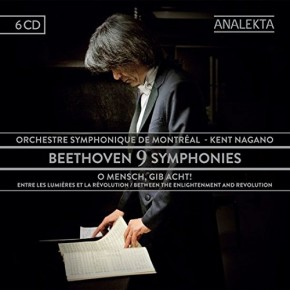Collectors may have come across Kent Nagano’s live Montréal Beethoven symphony recordings as individual releases on Sony Classical that lasted in the catalog for about 10 minutes, now reissued together on Analekta. Certain period-instrument movement traits have found their way into modern orchestral performances, such as generally fast tempos, lean textures, longer notes given shorter values, minimum vibrato, dynamic swells, and phrases tapered to the point of exaggeration. This holds true throughout Kent Nagano’s live Beethoven cycle, subtitled “O Mensch, gib acht! Between the Enlightenment and Revolution”.
Accordingly, each of the six discs bears its own heading. For example, Disc 1 is called “Departure—Utopia”, Disc 2 “The Poetry of Freedom”, while the Eroica (Symphony No. 3) and Prometheus Ballet excerpts fall under the rubric “Gods, Heroes, and Men”. Not that any of this matters when the music is concerned.
CD 1. Symphony No. 1’s first movement holds the key to what one should expect, with its bracing, opera buffa pace and scaled down fortissimos. The Andante cantabile is similarly brisk and just slightly cloying (the crescendo on the main theme’s upbeat, for example). Following a tightly aligned Scherzo, the finale’s Allegro molto lets rip with the violins scurrying about with impressive élan. While the Montréal musicians are miraculously unfazed by the breakneck tempos that Nagano chooses for the Seventh’s first, third, and fourth movements, the conductor all too often sacrifices detail for speed, such as the glossed over trills in the Presto Scherzo.
CD 2. Symphony No. 2’s first-movement introduction seamlessly dovetails into the main Allegro con brio, which benefits from Nagano’s relaxed buoyancy. The string tone appropriately opens up throughout the long second movement, and if the Scherzo’s short phrases don’t pass back and forth with conversational alertness, I like Nagano’s keen attention to inner lines in the Allegro molto, and his slightly unsettling yet oddly effective manner of rushing the declamatory opening motive.
CD 3. For all of the textural and textual clarity of Nagano’s Eroica, I am bothered by his overly coy downplaying of the first-movement exposition’s cross-rhythmic forte accents, the thin string tone in the Funeral March’s sustained passages that cry out for tonal heft, the speedy yet unpressurized Scherzo (robust horns notwithstanding), and the finale that begins gaunt and sprightly yet becomes slightly slower and heavier as it progresses. However, the selections from The Creature of Prometheus feature ideal tempos and wonderfully characterized first desk solo work, especially in the Andante quasi allegretto’s genial chamber-like interplay.
CD 4. Aside from mannered dynamic manipulation and eccentric balances at times, Symphony No. 5’s first three movements are packed with interesting details such as the first-movement development’s imitative woodwind licks so famously brought out in Klemperer’s stereo recording, and crisply specific alignment of the third movement’s fugal episodes. All the more surprising that the Finale second theme’s cello countermelody remains buried in the mix (so proudly prominent in the Dorati/London and Bernstein/New York recordings). The excellent Egmont selections and rarely heard, well performed Opferlied are followed by Weingartner’s string orchestra adaptation of the Grosse Fuge for string quartet. Its lengthy and gnarly first section is surprisingly heavy and stiff, while the minimum vibrato policy robs the Meno mosso e moderato of its inherent tenderness and lyrical qualities. Once the Allegro molto e con brio kicks in, the performance comes to vivid life.
CD 5. If Nagano strives to deliver a “different” Fifth, his Pastoral (No. 6) is nothing less than a normal, regulation reading, replete with “traditional” ritards and the cellos sneaking in more expressive inflections throughout the Finale than the HIP police allow. Only the flexibly lithe and transparent Andante molto mosso (what gorgeous euphony in the woodwind chording!) rises to something really special.
By contrast, Nagano and his musicians revel in the Eighth’s rollicking energy and wild ideas, helped by the conductor’s goosing up inner voices and accompaniments (never to the point of distraction, I might add). Few bring out the Allegretto scherzando’s popping pizzicatos as Nagano does, although the piano-like staccato woodwind chord accompaniment is not quite so pointed and alert as you’d expect (the Kletzki/Czech Philharmonic and first Solti/Chicago Symphony recordings nail this detail perfectly).
CD 6. Because the performances stem from live concerts in different venues, the sonics are variable. In contrast to the full bodied warmth and immediacy of Nos. 1, 2, 4, 5, and 7, the Ninth’s diffuse ambience projects what my reviewer colleague Mortimer F. Frank used to call the “wrong end of a telescope” effect. As a consequence, loud tuttis often sound congested, Mikhail Petrenko’s opening bass recitative in the “Ode to Joy” finale seemingly emerges from offstage rather than dead of center, and melodic strands go in and out of focus in the Scherzo. Still, one readily perceives Nagano’s penchant for linear clarity and tempo relationships that are carefully considered, save for the Finale’s ridiculously fast March.
For whatever virtues and drawbacks Nagano possesses as a Beethoven interpreter, he clearly knows what he wants to achieve in this repertoire, and the best of his work will no doubt hold interest and fascination among Beethoven lovers. What’s missing is the consistency of vision and execution of Beethoven cycles as disparate as those by Wand, Harnoncourt, Chailly, Schuricht, Klemperer, Szell, Dohnányi, Kletzki, Barenboim, Norrington (his Hänssler Stuttgart recordings), and Karajan from the 1970s. But if you’re interested, be aware that the discs come in a flimsy and precariously designed foldout cardboard and plastic package destined to fall apart sooner rather than later.
































